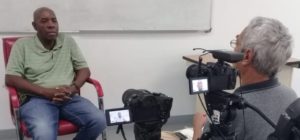|
Getting your Trinity Audio player ready...
|
Reading Time 2 mins

Kim Johnson (right) interviewed Leon “Smooth” Edwards, arranger of Trinidad All-Stars, at the Carnival Institute of T&T.
Kim Johnson’s The Illustrated Story of Pan took me away from my reading of Hubert Harrison’s “When Africa Awakes” and ushered me into a solid weekend (April 17-18) of Pan.
Pan Memories, like Sunland, the Tunapuna Steelband with members like “Dalgo,” Silver,” “Joe Dog,” “Monkey,” and “Wolf-Man” were quickly recalled.
This book made me recall Mrs. Melda, my mother’s friend who every year played mas in town, and “Sailor Morris,” our neighbor who played a sailor in Tunapuna. The Jemmott family, Orville Wright and Desmond Waithe brought back a flood of memories. I know Roy Augustus but was unaware of his significant role in the administrative thrust of the movement by way of Pan Trinbago.
The power plays at work for influence over the Steelband Movement by the P.N.M. and N.J.A.C. were revealing. So too was the African spiritual influence, the role of women in general, and music teachers in particular, on the development of the Steelband.
The book took me to places and times deeply embedded in my memory. It also carried me to a more complex understanding of the fundamental physics and metallurgy involved in making these instruments. It added another level of sophistication to our appreciation of the craft.
Kamau Odinga is a Pan-Africanist Community Organizer based in Hahnville, LA.


great review